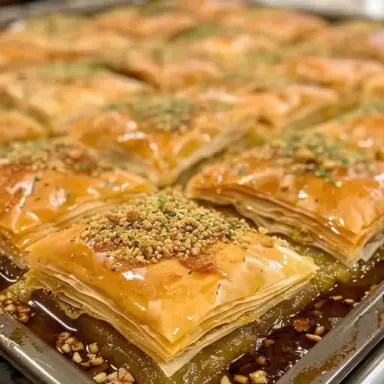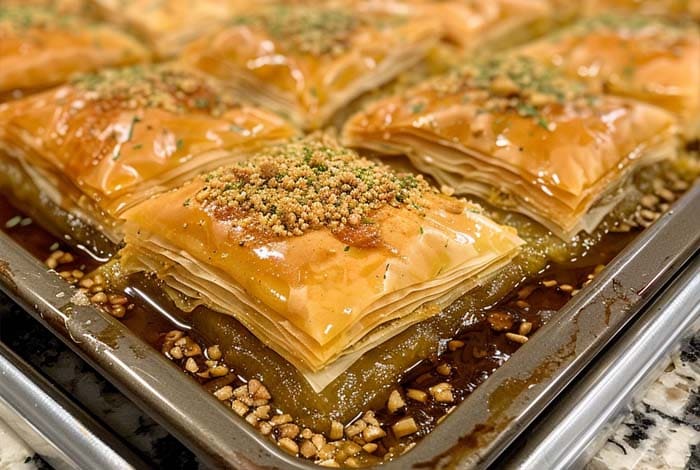Introduction to Greek Baklava
Greek Baklava is a testament to the rich tapestry of Mediterranean history, a dessert that transcends borders yet finds a unique expression in Greek cuisine. This delectable pastry, characterized by its flaky layers of phyllo dough, sweetened with syrup, and filled with nuts, is more than just a treat; it’s a cultural artifact. The origins of Baklava are often debated, with various cultures claiming it as their own, but it is undeniably a significant part of Greek culinary tradition, especially during celebrations and religious feasts.
The classic Greek Baklava recipe is a harmonious blend of simplicity and complexity. Its core ingredients—phyllo dough, nuts, and honey—are humble, yet the process of layering them requires patience and skill. The result is a dessert that is both crunchy and sweet, offering a burst of flavors with every bite. Greek Baklava is not just food; it’s a celebration of Greek heritage, a sweet link to the past, and a staple at any Greek table.
The origins of Baklava are debated across the Mediterranean, with influences from the Middle East, Central Asia, and Europe. Serious Eats breaks down the multi-cultural history of Baklava here.
Ingredients and Tools for Making Greek Baklava
Creating Baklava at home is an enjoyable process that requires a few specific ingredients and tools. Here’s what you’ll need:
Ingredients for Baklava:
- Phyllo Dough: The base of Baklava, providing its characteristic layers. Opt for high-quality phyllo for the best texture.
- Nuts: Traditionally, walnuts are used in Greek Baklava, but pistachios and almonds are also popular choices. The nuts add crunch and flavor to the dessert.
- Butter: Melted butter is brushed between each layer of phyllo, adding richness and helping the layers to crisp up during baking.
- Cinnamon and Clove: These spices are mixed with the nuts, infusing the Baklava with warm, aromatic flavors.
- Honey Syrup: A mixture of honey, water, sugar, and sometimes lemon or orange zest, this syrup is poured over the cooked Baklava, adding sweetness and moisture.
Tools and Equipment:
- Baking Pan: A large, rectangular baking pan is ideal for making Baklava.
- Brush: A pastry brush is necessary for buttering the phyllo layers.
- Sharp Knife: A sharp knife is crucial for cutting the Baklava into pieces before and after baking.
- Saucepan: Needed for preparing the honey syrup.
- Mixing Bowl: For mixing the nuts with spices.
Each ingredient in Baklava plays a crucial role. The phyllo dough adds the crispy texture, the nuts provide crunch and depth, the butter enriches the flavor, and the honey syrup brings sweetness and binds everything together. The tools, particularly the brush and sharp knife, ensure that the layers are perfectly assembled and cut, crucial steps in achieving the perfect Baklava.
How to Assemble and Bake Traditional Greek Baklava
Creating the perfect Greek Baklava is an art that combines simple ingredients with meticulous technique. Follow this step-by-step guide to achieve a dessert that’s as delightful to eat as it is to make.
Preparing the Phyllo Layers
Handling Phyllo Dough: Phyllo dough is delicate and dries out quickly. Keep the sheets covered with a damp towel when not in use. Work swiftly but gently to prevent tearing. If a sheet does tear, don’t worry; the layers will hide any imperfections.
Layering and Buttering Techniques: Melt your butter ahead of time and have a pastry brush handy. Place one sheet of phyllo in the bottom of your baking pan and brush it lightly but thoroughly with melted butter. Repeat this process until you have layered about 10-12 sheets, creating a sturdy base for your filling.
Nut Mixture Preparation
Choosing and Mixing Nuts: Finely chop your choice of nuts—walnuts, pistachios, and almonds are all excellent options. For a traditional Greek flavor, walnuts are preferred. Mix the chopped nuts with cinnamon and clove, ensuring an even distribution of spice.
Seasoning: The addition of cinnamon and clove provides a warm, aromatic flavor that complements the sweetness of the syrup and the nuttiness of the filling. Adjust the quantity based on your taste preferences, but a general guideline is about 1 teaspoon of cinnamon and 1/4 teaspoon of clove for every 2 cups of nuts.
Assembling the Baklava
Layering Order and Technique: After your base layers of phyllo, spread the nut mixture evenly over the top. Begin layering more phyllo sheets on top of the nuts, brushing each with butter as before. Use about 10-12 sheets for the top layers, ensuring the final layer is well coated with butter.
Cutting the Baklava Before Baking: With a sharp knife, cut the Baklava into diamond or square shapes all the way through to the bottom layer. This step is crucial for allowing the syrup to permeate the dessert evenly after baking.
Baking and Syrup Preparation
Baking Temperature and Time: Preheat your oven to 160°C (320°F). Bake the Baklava for about 50-60 minutes, or until the phyllo is golden and crisp. Keep an eye on it, as oven temperatures can vary.
Syrup Ingredients and Cooking Method: While the Baklava bakes, prepare the syrup. Combine 1 cup of water, 2 cups of sugar, 1/2 cup of honey, and a strip of lemon or orange zest in a saucepan. Bring to a boil, then simmer for about 10 minutes. Let it cool slightly.
Pouring the Syrup: Timing and Technique: As soon as the Baklava comes out of the oven, evenly pour the warm (not hot) syrup over the hot Baklava. The contrast in temperatures helps the syrup absorb better, ensuring each layer is sweetened.
Let the Baklava cool completely in the pan before serving. This waiting period allows the syrup to soak through all the layers, melding the flavors and textures into a harmonious dessert. The result is a crispy, nutty, and perfectly sweetened Baklava that pays homage to its Greek origins. Enjoy the process and the delicious outcome of your labor!
Serving Suggestions for Authentic Greek Baklava
How to Serve Greek Baklava
Greek Baklava is best served at room temperature, allowing the flavors and textures to fully express themselves. For an extra touch of elegance, dust lightly with powdered sugar or a sprinkle of ground cinnamon. Pairing Baklava with a strong Greek coffee or a sweet dessert wine can elevate the dessert experience, balancing the sweetness with a hint of bitterness or acidity.
How to Store Greek Baklava for Maximum Freshness
To keep Baklava fresh, store it in an airtight container at room temperature. Avoid refrigerating as the humidity can make the phyllo layers soggy. If you must extend its shelf life, Baklava can be frozen in airtight containers and thawed at room temperature before serving.
FAQs
Can I Use Different Nuts in My Baklava?
- Absolutely! While walnuts are traditional, feel free to experiment with pistachios, almonds, or a mix of your favorite nuts. Each type of nut offers a unique flavor and texture to the dessert.
How Do I Prevent My Phyllo Dough from Drying Out?
- Keep the phyllo dough covered with a damp cloth or plastic wrap while you work. This prevents it from drying out and becoming brittle, making it easier to handle.
Can Baklava Be Made Ahead of Time?
- Yes, Baklava is an excellent make-ahead dessert. Its flavors develop and improve over a day or two, making it perfect for preparing in advance for special occasions.
How Long Does Baklava Last?
- Properly stored in an airtight container, Baklava can last up to two weeks at room temperature. For longer storage, it can be frozen for up to 3 months.
Advanced Tips and Variations
Variations in Nuts and Spices
Don’t hesitate to experiment with different combinations of nuts and spices. Adding cardamom or nutmeg can introduce new flavors to your Baklava. Similarly, experimenting with the ratios of walnuts, pistachios, and almonds can create different taste profiles.
Making Vegan Baklava
To make vegan Baklava, substitute the butter with a high-quality plant-based alternative. Look for a vegan butter that has a high fat content for the best results. For the syrup, ensure that your sugar and honey substitutes are vegan-friendly.
Creative Serving Suggestions
For a modern twist, serve Baklava with a scoop of vanilla or cinnamon ice cream. You can also drizzle it with chocolate or caramel sauce for an extra layer of decadence. Another idea is to layer Baklava crumbs with Greek yogurt and fresh fruits for a Baklava-inspired parfait.
Exploring these variations and serving suggestions can make your Baklava experience uniquely delightful, showcasing the versatility and enduring appeal of this classic dessert.

Greek Baklava Recipe
Equipment
- Large baking pan (approx. 9x13 inches)
- Pastry Brush
- Sharp knife
- Saucepan
- Mixing bowl
Ingredients
For the Baklava:
- 1 package 16 oz phyllo dough, thawed
- 2 cups walnuts finely chopped
- 1 teaspoon ground cinnamon
- 1/4 teaspoon ground clove
- 1 cup unsalted butter melted
For the Syrup:
- 1 cup water
- 1 cup sugar
- 1/2 cup honey
- 1 cinnamon stick
- Zest of 1 lemon
Instructions
- Preheat oven to 160°C (320°F).
- Prepare Phyllo: Brush the bottom and sides of the baking pan with butter. Layer 10-12 sheets of phyllo in the pan, brushing each sheet with melted butter.
- Mix Nuts: Combine chopped walnuts, cinnamon, and clove. Spread evenly over the phyllo in the pan.
- Layer: Continue layering and buttering the remaining phyllo sheets on top of the nut mixture.
- Cut: Before baking, cut the Baklava into diamond or square shapes.
- Bake: for 50-60 minutes, or until golden and crisp.
- Make Syrup: While Baklava bakes, combine water, sugar, honey, cinnamon stick, and lemon zest in a saucepan. Bring to a boil, then simmer for 10 minutes. Remove the cinnamon stick and lemon zest.
- Finish: Pour the warm syrup over the hot Baklava. Let cool completely before serving.
Notes
- Phyllo Dough: Keep the phyllo covered with a damp towel when not in use to prevent drying.
- Cutting Baklava: Be sure to cut Baklava before baking to ensure the syrup soaks through properly.
- Serving: Baklava is best enjoyed at room temperature. Store in an airtight container to maintain freshness.
- Variations: Feel free to experiment with different nuts or add a teaspoon of rose water to the syrup for a floral note.

